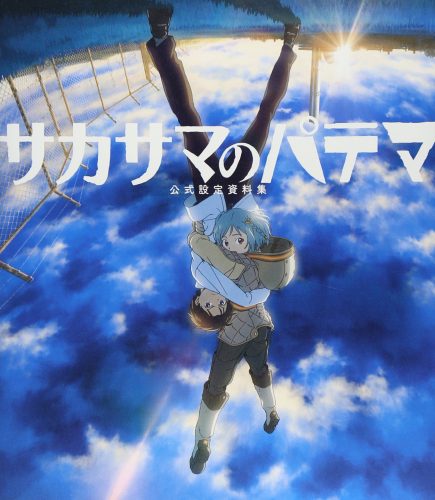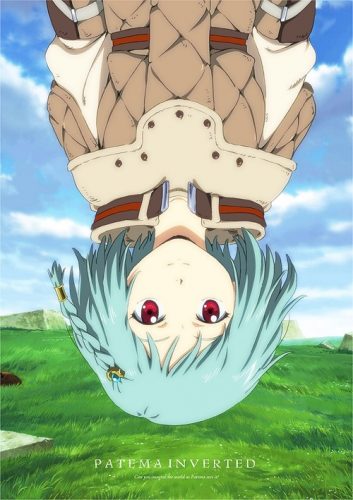
Sakasama no Patema (Patema Inverted) is a film directed and written by Yasuhiro Yoshiura, most known as the director and original creator of the Time of Eve movie and TV series. His next work, Sakasama no Patema (Patema Inverted), tells a story about the aftermath of an explosion. Following this event, gravity becomes inverted and some humans “fall upwards.” Survivors escape towards the earth, burrowing themselves to start society anew.
For this article, I will briefly discuss architecture in Patema Inverted and how viewers can infer a character’s belief and the film’s story from it. Once understood, how the story uses its structure to present its ideas becomes apparent, revealing the power of literary and visual worldbuilding.
Setting Up Structure: Worldbuilding in Sakasama no Patema (Patema Inverted)
Patema Inverted has a knack for “structure,” conveyed through its clean writing and expressive architecture. Throughout the movie, two societies are presented back-to-back, and by flipping from different perspectives, viewers are encouraged to make observations.
To guide their respective citizens (and the viewers), the chief of Patema’s village and the ruler of Aiga have a set of rules, one of which is never to interact with outsiders. From these rules, the building blocks—the structures of their respective societies—are formed both ethically and physically.
Patema’s country exists underground. Buildings are built into the rocks with pipes connecting one rusty structure to the next. Elevator shafts even transport characters throughout the city, fashioning the impression of an underground mine.
While not overly filthy, Patema’s city is logically filled with dirt and debris. Outside her house even, a pile of rocks rests. Her house itself uses the old remnants of civilization, fit with its own archaic AC system. The city lives in the past, molding its buildings into the environment. After returning from the danger zone, Patema is greeted by the citizens. They gleefully state they found seeds to plant for food.
This interaction provides viewers with an understanding: that it’s not just the buildings that are in close proximity—the people are close like a family. Despite living underground, the entire city is filled with brightness, mirroring its people. This is in direct contrast to Aiga’s “utopian city.”
Setting Up Structure: Worldbuilding in the Aigan Society
Aiga has a hierarchical structure. At the center, a military tower looms over its society, watching like an ominous sentinel. Within this tower, soldiers live within unmarked doors, facing towards an excessive amount of cameras. Each side of the building prioritizes efficiency—packing as many soldiers together as possible. These living quarters are indistinguishable and inhumanely clean as if to say, “Robots live here.”
Outside of this tower, there is a conveyor belt. This conveyor belt runs through the city, transporting citizens like tools to their respective destinations. When this belt is first introduced, a siren blares throughout the city, indicating it’s time for a “proper education.” Age, the male protagonist, lines up for school. He quickly hides his expression and stares at his feet like the others.
Various shots of the buildings are provided then, clean and white from afar but dirty with observation. From the outside, the city looks like a factory. Workers with hard hats are shown adjacent to propaganda posters that read “[A] Hard Hand for [the] Motherland.”
Upon nearing the school, a video is played for the students: “Aiga is the only true world in which humanity exists. There is no world but Aiga. We must keep our eyes firmly on our feet, follow the laws and maintain order, as we continue to preserve our precious land.” The protagonist looks up towards the sky.
However, looking upwards is a “sin,” and Age is quickly reprimanded. Within Aiga, the ruler enforces laws like a religion. To him, those who floated towards the sky are sinners. To avoid this fate, Aigan must maintain its purity through law and order.
Breaking the Mold: Seeing A New World
In Patema Inverted, there is a central belief: a character’s perspective is their foundation. It is the ground on which they walk. They stand firmly upon their beliefs, claiming their world is “right-side up.” However, when characters from a different perspective interact, their worldview becomes challenged.
When Patema meets Age, their opposing beliefs clash, the dialogue making it explicit. Both Patema and Age fight over something seemingly trivial—that the other is upside down. This refusal to agree is childish. Their refusal to see from the other perspective is the core problem of the film.
This is further supported by the previous section—their societies are formed in direct contrast to one another. This is why each leader has adamantly refused outsiders into their home. Interaction between opposing worldviews turns each society “upside down.”
From this point, the story heads in a new direction. It wants to convince its characters that despite opposing viewpoints, each society needs one another. Despite Aiga turning its citizens into “tools of the government” and Patema’s society being treated as subhuman (they are derogatorily called “inverts” and live literally below the Aigans), that humanity shouldn’t live inside a box.
From here, viewers can understand why structure can be valuable and dangerous. Structure provides organization and categorization. You can infer information simply by structure, from literal buildings and even implications of a story’s writing. However, an unmalleable structure is a prison. To categorizing humanity into a small box festers conflict, reduces our empathy, and steals away our agency—the freedom for thoughts and choices.
Patema Inverted capitalizes on its beliefs. As Patema and Age escape pursuing soldier, the Aigan ruler aims his gun, readying for the kill. In the following conflict, the ground beneath them shatters, revealing the world from before the explosion; the Aigan ruler falls towards the “new world’s” sky, as if punishing his sins.
In the final scene of the film, Patema and Age hold one another, sharing a vision of a ruined city surrounded by wildlife and growth. The camera moves to a bird’s eye view of the hole where the characters emerged, proving that all of humanity had escaped underground together.
Final Thoughts

Sakasama no Patema (Patema Inverted) is a worthwhile film for its concepts and ease of entry. For viewers curious about camera angles and perspectives, Patema Inverted sticks to its name by providing shots with obvious shifts. What is a beautiful sky for one character is impending death for another. Through direct inversion and a clean script, the film teaches viewers the power of perspective.

